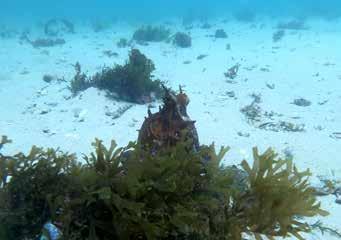20
www.thevillagenews.co.za
9 December 2020
MY ENVIRONMENT
A Christmas gift from nature By Dr Anina Lee
After going through 4 – 5 instar stages, they become mature larvae or caterpillars. The caterpillars look quite different from the instars. They are mostly green with white and yellow markings and black 'eyespots'. The green caterpillars are relatively well hidden on citrus trees, but they have an additional defence mechanism. When a bird or other predator tries to catch it, the caterpillar rears up and uses blood pressure to squeeze out a forked, finger-like, orange-coloured organ called an 'osmeterium' from just behind its head.
I
am saddened by the rampant consumerism that is associated with Christmas. While supporting local businesses is a good thing when purchasing what you need, buying goods for the sake of buying is bad for the planet.
The biggest threats to Planet Earth are not only the burgeoning number of people on it but also the rate at which the wealthy consume resources. Thus the USA consumes more resources and causes more planetary pollution than India, although the USA has only 35% of the population of India. What, you say, should I then give my grandchildren for Christmas? In my view, the most precious gift we can bestow on children is to spend time with them – preferably in nature, away from the television, mobile phones and other devices. The gift of knowledge and love of nature will last a lifetime. Exploring nature leaves almost no carbon footprint, nor drives resource consumption. For example, gift your loved ones a boat trip to spot sharks, whales, dolphins or even a Mola mola in Walker Bay. Or book a guided fynbos walk with a tour guide or Botanical Society. Gift a spot on one of the many nature activities offered by Whale Coast Conservation: spotting chameleons at night, exploring the hidden wildlife on the beach, or walking through an ancient milkwood forest and learning about its ecology and history. By gifting one of these activities with
The ‘Christmas Butterfly’, or Citrus Swallowtail Butterfly (Papilio demodocus) is a beautiful black and yellow butterfly that can be spotted in gardens around South Africa. As the name implies, the caterpillars are partial to the leaves of citrus trees. PHOTO: naturebackin.com local organisations, you will support the vital work they do in environmental education and in caring for our local natural treasures. Talking about caring – why not join a Cliff Path alien hacking group or a coastal clean-up? Donate your time – and that of your nearest and dearest – to a good cause. Our bookshops, gardens, parks and beaches have a wealth of fascinating things to explore. For example, here is a topic, appropriate to the festive season, that you can share with your loved ones – the beautiful ‘Christmas Butterfly’, or Citrus Swallowtail Butterfly (Papilio demodocus). This lovely black and yellow butterfly can be spotted in gardens around South Africa. While the adult butterfly is a gorgeous visitor, some gardeners may not welcome the larvae, also known as caterpillars. As the name implies, the caterpillars are partial to the leaves of citrus trees. I have a lemon tree in my garden and have waited expectantly – but in vain – for them to come and
feast. But if you are lucky enough to host these beauties on your lemon tree, do not despair when you see the tree stripped bare of leaves. The butterfly and its tree host have evolved together in harmony, and the tree will simply sprout more leaves. These butterfly larvae also eat plants in the carrot family, like dill, parsley and fennel.
The organ could be mistaken for a snake's tongue, and it also has a strong, pungent smell to deter the predator. Scientists believe that the smell is derived from chemicals in the oil glands of the leaves eaten by the caterpillar. When the caterpillar has grown to its maximum size of about 45mm, it lassoes itself to a branch with a strong strand of silk and pupates – that is, it becomes a pupa. Over the next few weeks, an amazing transformation takes place inside the pupa, in which the larva changes into a butterfly. The winged butterfly has a different diet, feeding mainly on flower nectar. A butterfly's sole purpose in life is to
"go forth and multiply". When a male Swallowtail spots a female, he will hover over her and emit a chemical called a pheromone to signal his desire to mate. If the female accepts him, mating will take place. In the process, the male transfers a 'nuptial gift' of sperm and protein (called a 'spermatophore') to the female. The spermatophore is then absorbed, and its nutrient (protein) contents are given to the female's eggs as a food source. The male dies soon after, having fulfilled his destiny. The female flies off to find a suitable host plant for her eggs. She lays about a hundred eggs and then she, too, dies. Out of the hundred eggs, an average of two will survive to maturity, replacing the two parents in the population. Thus is the balance in nature – eat and be eaten. This way animals keep a constant population that can be supported by the environment in which the species live. You cannot give a better gift for Christmas than an adventure in nature, which may well inspire our loved ones to learn more about its marvels – and with understanding comes caring for the wondrous planet on which we live.
Butterflies are insects, so they go through a life cycle of different forms, known as 'metamorphosis'. The life cycle of the Citrus Swallowtail has been beautifully captured in a blog by naturebackin.com. The female butterfly lays a single egg on many individual leaves of the host plant. When the tiny immature caterpillars (called 'instars') hatch, they are most vulnerable to predators like birds. So what better camouflage than to look like a bird dropping. Larvae eat voraciously and grow rapidly. As they grow, they have to shed their outer cuticle (skin) in a process called moulting.
LEFT: The male Swallowtail dies shortly after mating, while the female flies off to find a suitable host plant for her eggs. She lays about 100 eggs and then she, too, dies. An average of only two eggs will survive to maturity, replacing the two parents in the population. PHOTO: naturebackin. com. RIGHT: The green caterpillars have a hidden defence mechanism. When a bird or other predator tries to catch it, the caterpillar rears up and uses blood pressure to squeeze out a forked, orange-coloured organ called an 'osmeterium' which looks like a snake’s tongue and has a strong, pungent smell to deter the predator. PHOTO: Jon Richfield, Wikimedia Commons
















